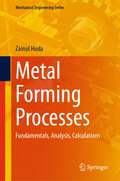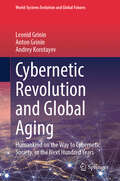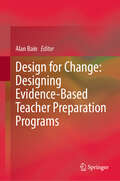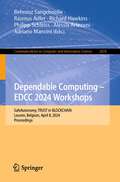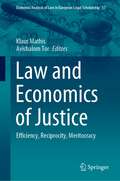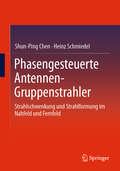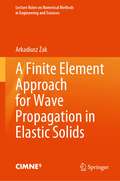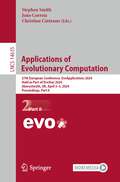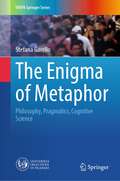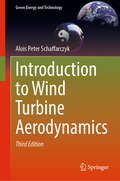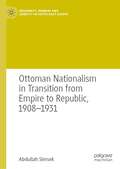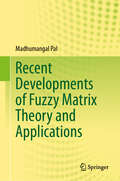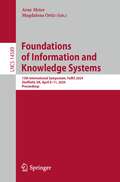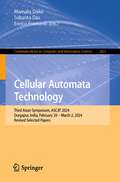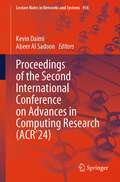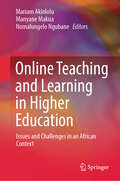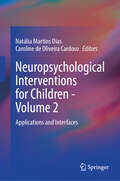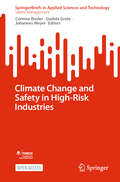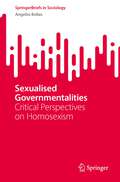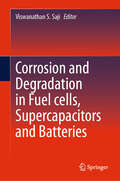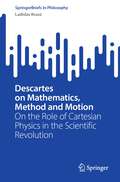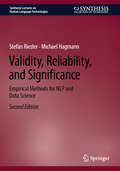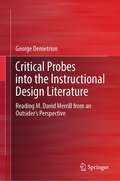- Table View
- List View
Metal Forming Processes: Fundamentals, Analysis, Calculations (Mechanical Engineering Series)
by Zainul HudaThis unique textbook features fundamentals and analyses of metal forming processes supported by 200 worked numerical examples. It provides rigorous detail on the three all-important groups of metal-forming processes: bulk-metal forming, sheet-metal forming, and sheet-bulk-metal forming. Theory of metal forming is presented by discussing deformation behavior, plasticity, and formability with a thorough mathematical analyses and calculations. The mechanics of sheet metal forming is also covered by including principal strain increments in uniaxial loading as well as plane stress deformation. There are 125 diagrammatic illustrations/real-life photographs that have been labelled properly to enhance the understanding of readers. Among the salient features of the book is the inclusion of industrially-oriented projects, covering both technological and business considerations. The key solutions connected to these projects are presented with the aid of mathematical analysis and process flow diagrams. The book includes 100 multiple-choice questions (MCQs) with their answers and those for selected problems facilitating self-directed learning.
Cybernetic Revolution and Global Aging: Humankind on the Way to Cybernetic Society, or the Next Hundred Years (World-Systems Evolution and Global Futures)
by Leonid Grinin Andrey Korotayev Anton GrininThis book explores the global technological transformations that have shaped development of society for eons, from the emergence of Homo sapiens to the modern day. Looking at a potential future for all of this century and the beginning of the next, the book explores how society is changing as a result of the two most powerful trends: technological advances and global aging. It studies the forthcoming technological wave – the Cybernetic Revolution, which will encompass AI, medical technology and biotechnology, robotics, cognitive, nanotechnology etc. In turn, it shows why and how global aging will become one of the most powerful factors, influencing the evolution of society and the World System as a whole. Lastly, the book demonstrates how technological innovations can change the way people live and the society of the future, assessing both the new opportunities and threats posed by uncontrolled technological progress. Accordingly, it will appeal to social scientists, political scientists, economists and historians who are interested in technological transformations and their social and economic impacts.
Design for Change: Designing Evidence-Based Teacher Preparation Programs
by Alan BainThis book focuses on enhancing teacher education quality by making evidence- informed decisions about policy, assessing quality, establishing effective strategies, and innovating teacher preparation programs. It advocates for the importance of rigorous program design and evaluation as the basis for shaping policy directions and claiming program effectiveness. The book introduces "Design for Change" (DfC), a 20-year-long collaborative effort by a group of teacher educators dedicated to improving their practices. DfC is divided into two parts: Design for Change-Teams and Process (DfC-TaP) and Design for Change-Programs and Courses (DfC-PaC). DfC-TaP explores how to form and sustain a design team of academics, emphasizing the collaborative process's value in program development. DfC-PaC delves into applying practical theory to curriculum design, mapping programs to standards, creating meaningful learning and assessment tasks, and leveraging technology. The latterincludes a chapter on software for teacher preparation program design. The book's ultimate goal is to offer a versatile framework for designing teacher education programs. The book employs evidence from longitudinal research to present generalizable concepts and structures for program developers and designers. By doing so, the book aims to contribute to the field by providing a research-based guide for building teacher education programs that enhance the overall educational experience for both faculty and students.
Dependable Computing – EDCC 2024 Workshops: SafeAutonomy, TRUST in BLOCKCHAIN, Leuven, Belgium, April 8, 2024, Proceedings (Communications in Computer and Information Science #2078)
by Behrooz Sangchoolie Rasmus Adler Richard Hawkins Philipp Schleiss Alessia Arteconi Adriano ManciniThis book constitutes the refereed proceedings of Workshops held at the 19th European Dependable Computing Conference, EDCC 2024: First Workshop on Safe Autonomous Systems, SafeAutonomy 2024, and the First Workshop on the Role of TRUST in the implementation of Digital Technologies: Blockchain Technology and Artificial Intelligence in Smart Cities, TRUST IN BLOCKCHAIN 2024. The 13 workshop papers presented in this book were thoroughly reviewed and selected from 14 submissions. The TRUST IN BLOCKCHAIN workshop accepted extended abstract submissions, whereas the SafeAutonomy workshop accepted regular technical papers, case studies, PhD forum papers, as well as position papers. They deal with latest research results on theory, techniques, systems, and tools for the design, validation, operationand evaluation of dependable and secure computing systems.
Law and Economics of Justice: Efficiency, Reciprocity, Meritocracy (Economic Analysis of Law in European Legal Scholarship #17)
by Klaus Mathis Avishalom TorWhile previous volumes have examined specific issues and developments such as the coronavirus crisis or digital transformation from a law and economics perspective, the anniversary edition returns to the methodological and philosophical fundament of the discipline of law and economics. The present book aims to examine these foundations in general and, in particular, efficiency, reciprocity and meritocracy, and their relation to law and justice from an interdisciplinary perspective.Efficiency: Traditionally, the economic analysis of law has been guided by the goal of efficiency. Economists usually define efficiency as Pareto or Kaldor–Hicks efficiency. Any change that makes one member of society better off without anyone else being worse off is a Pareto improvement. A change is a Kaldor–Hicks improvement if the gainers value their gains more than the losers value their losses, with only hypothetical compensation required.Reciprocity: Economists have traditionally basedtheir models on the self-interest hypothesis of homo oeconomicus. In this model, an individual maximises his own utility without being altruistic or jealous. Behavioural economics challenges the self-interest hypothesis. In fact, many people deviate from purely self-interested behaviour. There are also signs that considerations of fairness and mutual benefit are important in bilateral negotiations and in the functioning of markets. Meritocracy: The concept of meritocracy refers to a system, organisation, or society in which people are selected and promoted to positions of success, power, and influence on the basis of their abilities and merits. This means that an individual is able to climb the social ladder through hard work. Moreover, meritocracy directs the most talented people into the most functionally important positions, thereby increasing a society's efficiency. However, the equalising function of meritocracy has been criticised. Rather than reducing inequality, meritocracy is seen as the cause of racial, economic and social inequality.
Phasengesteuerte Antennen- Gruppenstrahler: Strahlschwenkung und Strahlformung im Nahfeld und Fernfeld
by Shun-Ping Chen Heinz SchmiedelIn diesem Buch werden die Grundlagen der Strahlformung von Antennen erläutert. Die Prinzipien der Strahlfokussierung und Strahlschwenkung im Nah- und Fernfeld werden mit 2D- und 3D-Simulationen visualisiert und mit Messergebnissen verglichen. Neben linearen und planaren Antennen-Gruppenstrahlern werden auch konforme Gruppenstrahler, also konkave und konvexe Antennen-Gruppenstrahler, die für bestimmte Anwendungen geeignet sind, untersucht und vorgestellt. Auch verwandte Anwendungen der Strahlformung, wie Open-Loop- und Closed-Loop-Antennen-Gruppenstrahler oder Massive MIMO, eine der bahnbrechenden Technologien für 5G und zukünftiges 6G, die eine extrem große Anzahl von Antennenelementen für die Multi-Nutzer-Funkversorgung erfordert, werden behandelt. Weiterhin wird auch Strahlformung der sogenannten ausgedünnten Antennen-Gruppenstrahler mit großen Abständen zwischen den Antennenelementen diskutiert. Dieses Buch richtet sich sowohl an Forschungs- und Entwicklungsingenieure als auch an Studierende in den Bereichen Hochfrequenztechnik und Telekommunikation.
Cell Biology and Translational Medicine, Volume 21: Stem Cell in Lineage, Secretome Regulation and Cancer (Advances in Experimental Medicine and Biology #1450)
by Kursad TurksenMuch research has focused on the basic cellular and molecular biological aspects of stem cells. Much of this research has been fueled by their potential for use in regenerative medicine applications, which has in turn spurred growing numbers of translational and clinical studies. However, more work is needed if the potential is to be realized for improvement of the lives and well-being of patients with numerous diseases and conditions.This book series 'Cell Biology and Translational Medicine (CBTMED)' as part of Springer Nature’s longstanding and very successful Advances in Experimental Medicine and Biology book series, has the goal to accelerate advances by timely information exchange. Emerging areas of regenerative medicine and translational aspects of stem cells are covered in each volume. Outstanding researchers are recruited to highlight developments and remaining challenges in both the basic research and clinical arenas. This current book is the 21stvolume of a continuing series.
A Finite Element Approach for Wave Propagation in Elastic Solids (Lecture Notes on Numerical Methods in Engineering and Sciences)
by Arkadiusz ŻakThis book focuses on wave propagation phenomena in elastic solids modelled by the use of the finite element method. Although the latter is a well-established and popular numerical tool used by engineers and researchers all around the word the process of modelling of wave propagation can still be a challenge. The book introduces a reader to the problem by presenting a historical background and offering a broad perspective on the development of modern science and numerical methods. The principles of wave phenomena are clearly presented to the reader as well as the necessary background for understanding the finite element method, which is the following chapter of the book is viewed from the modeller point-of-view. Apart from the principles the book also addresses more advanced topics and problems including the use of the spectral-finite element method, the spline-based finite element method as well as the problems of undesired and hidden properties of discrete numerical models.
Applications of Evolutionary Computation: 27th European Conference, EvoApplications 2024, Held as Part of EvoStar 2024, Aberystwyth, UK, April 3–5, 2024, Proceedings, Part II (Lecture Notes in Computer Science #14635)
by Stephen Smith João Correia Christian CintranoThe two-volume set LNCS 14634 and 14635 constitutes the refereed proceedings of the 27th European Conference on Applications of Evolutionary Computation, EvoApplications 2024, held as part of EvoStar 2024, in Aberystwyth, UK, April 3–5, 2024, and co-located with the EvoStar events, EvoCOP, EvoMUSART, and EuroGP.The 51 full papers presented in these proceedings were carefully reviewed and selected from 77 submissions. The papers have been organized in the following topical sections: applications of evolutionary computation; analysis of evolutionary computation methods: theory, empirics, and real-world applications; computational intelligence for sustainability; evolutionary computation in edge, fog, and cloud computing; evolutionary computation in image analysis, signal processing and pattern recognition; evolutionary machine learning; machine learning and AI in digital healthcare and personalized medicine; problem landscape analysis for efficient optimization; softcomputing applied to games; and surrogate-assisted evolutionary optimisation.
The Enigma of Metaphor: Philosophy, Pragmatics, Cognitive Science (UNIPA Springer Series)
by Stefana GarelloThis book deals with the complicated realm of metaphor, an enigma deeply embedded in language and cognition. There has been much discussion of metaphor in the past, but it was characterized by a certain fragmentation and lacked interdisciplinarity. In this field of study, the dominance of Cognitive Linguistics, epitomized by the Conceptual Metaphor Theory of George Lakoff and Mark Johnson, has caused the marginalization of alternative perspectives. To fill this gap, this book embarks on an interdisciplinary journey, inviting different theoretical frameworks to engage in a fruitful dialog. It navigates the labyrinth of theories and illuminates the nuanced facets of metaphor.At the center of this exploration are three central questions: whether metaphor belongs to the realm of style or thought, the intricate interplays between literal and metaphorical meanings and the integration of propositional and non-propositional elements in the construction of metaphorical meaning.Through a careful blend of historical analysis and contemporary hypotheses, the book unravels the complexities of metaphor, considering its evolution across the centuries and the myriad interpretations it evokes. By bringing together work from different fields, it ultimately shows that a definition of metaphor is theory-dependent and that metaphor is not a natural kind, but a complex and multifaceted philosophical concept whose study requires a multi-dimensional approach that transcends narrow theoretical boundaries. In this way, the book explores these considerations’ most important philosophical consequences and offers new insights into this fundamental aspect of human language.
Introduction to Wind Turbine Aerodynamics (Green Energy and Technology)
by Alois Peter SchaffarczykThis book is an introduction to wind turbine aerodynamics for professionals and students with a diverse range of backgrounds. It is a self-contained textbook that shows how to progress from the basics of fluid mechanics to modern wind turbine blade design. It presents the fundamentals of fluid dynamics and inflow conditions, as well as extensive information on theories describing the aerodynamics of wind turbines. After examining a number of related experiments, the book applies the lessons learned to blade design.The text of this 3rd edition has been thoroughly revised, and the book includes a new section on aerodynamic design and optimization.
Ottoman Nationalism in Transition from Empire to Republic, 1908–1931 (Modernity, Memory and Identity in South-East Europe)
by Abdullah SimsekThis book deals with the complex process of national identity formation in the late Ottoman Empire and early Turkish Republic, during a crucial period characterized by transformative events that reshaped both the state and society. These events included revolutions, wars, mass migrations, ethnic cleansing, genocide, the empire's disintegration, territorial and demographic changes, and the emergence of new states. In the face of these events, a multitude of old and new formulations and imaginings of nation and national identity took shape and interacted with each other. This book focuses on highlighting the diversity of concepts and trajectories that existed during the period and how these played out within a complex web of inclusionary and exclusionary processes, and the various ways in which the nation was constituted and conceptualized.
Recent Developments of Fuzzy Matrix Theory and Applications
by Madhumangal PalThis book provides a comprehensive overview of the development of fuzzy matrix theory from its inception to its current state. It covers various types of fuzzy matrices, such as intuitionistic fuzzy matrices, interval-valued fuzzy matrices, interval-valued intuitionistic fuzzy matrices, bipolar fuzzy matrices, picture fuzzy matrices, neutrosophic fuzzy matrices, m-polar fuzzy matrices and similar one. Drawing primarily from the author's research work and collaborations, the book offers a state-of-the-art discussion of these topics. Theoretical concepts are illustrated with examples for clarity, accompanied by figures depicting fuzzy matrices and their variations. Suitable for both beginners and expert researchers, the book offers a wealth of material and includes numerous open problems at the end of almost all chapters to encourage further exploration and investigation.
Foundations of Information and Knowledge Systems: 13th International Symposium, FoIKS 2024, Sheffield, UK, April 8–11, 2024, Proceedings (Lecture Notes in Computer Science #14589)
by Arne Meier Magdalena OrtizThis LNCS conference volume constitutes the proceedings of the 13th International Symposium, FoIKS 2024, in Sheffield, UK, in April 2024. The 18 full papers together with 3 short papers included in this volume were carefully reviewed and selected from 42 submissions.The Symposium focuses on fundamental aspect of information and knowledge systems, including submissions that apply ideas, theories, or methods from specific disciplines to information and knowledge systems. Examples of such disciplines are discrete mathematics, logic and algebra, model theory, databases, information theory, complexity theory, algorithmics and computation, statistics, and optimization.
Cellular Automata Technology: Third Asian Symposium, ASCAT 2024, Durgapur, India, February 29–March 2, 2024, Revised Selected Papers (Communications in Computer and Information Science #2021)
by Mamata Dalui Sukanta Das Enrico FormentiThis book constitutes the refereed conference proceedings of the Third Asian Symposium on Cellular Automata Technology, ASCAT 2024, held in Durgapur, India, during February 29 - March 2, 2024.The 15 full papers presented in this book were carefully reviewed and selected from 33 submissions. The symposium aims to explore the latest advancements, methodologies, and interdisciplinary connections that showcase the versatility and potential impact of cellular automata in contemporary research.
Proceedings of the Second International Conference on Advances in Computing Research (Lecture Notes in Networks and Systems #956)
by Kevin Daimi Abeer Al SadoonThis book concentrates on advances in research in the areas of computational intelligence, cybersecurity engineering, data analytics, network and communications, cloud and mobile computing, and robotics and automation. The Second International Conference on Advances in Computing Research (ACR’24), June 3–5, 2024, in Madrid, brings together a diverse group of researchers from all over the world with the intent of fostering collaboration and dissemination of the advances in computing technologies. The conference is aptly segmented into six tracks to promote a birds-of-the-same-feather congregation and maximize participation. It introduces the concepts, techniques, methods, approaches, and trends needed by researchers, graduate students, specialists, and educators for keeping current and enhancing their research and knowledge in these areas.
Online Teaching and Learning in Higher Education: Issues and Challenges in an African Context
by Mariam Akinlolu Manyane Makua Nomalungelo NgubaneThis edited volume explores current practices in African higher education during and post the global pandemic. It fills a gap in the existing literature by focusing on student engagement and online learning in South Africa and examines how pandemic restrictions amplified pre-existing inequalities within the higher education sector.The book is divided into 3 sections: The first section discusses various methods of instruction and the use of online tools for facilitating learning; succeeded by a section focusing on the resource implications of moving to online learning platforms from a social justice perspective; and finally the last section considers issues and concerns about online assessments and quality assurance.Drawing on lessons from the experiences of South African educators and students during the pandemic, this book provides a knowledge base essential for the effective management of online teaching and learning in Africa. It is intended for academic stakeholders, to develop and engender an improved higher education climate.
Neuropsychological Interventions for Children - Volume 2: Applications and Interfaces
by Caroline de Oliveira Cardoso Natália Martins DiasThis book is the second of two volumes that aim to serve as a comprehensive guide for professionals working with neuropsychological interventions especially designed for children. This second volume complements the theoretical and practical foundations presented in the first volume by presenting applications to different clinical conditions and by exploring interfaces of neuropsychology with other areas of research and practice. Chapters in this second volume are divided into two parts. The first part presents a series of case studies, illustrating the practice and experience of neuropsychological rehabilitation and habilitation in different clinical conditions. The second part brings together chapters that discuss the interfaces of neuropsychology with different areas, which can use its knowledge and interventions (such as school neuropsychology) or which can be used as strategies within neuropsychological intervention or even compose inter and transdisciplinary partnerships in the work of promotion, stimulation, or cognitive remediation, such as the use and role of music, games and play, mindfulness, and transcranial direct current stimulation. So, chapters in this second part highlight the interfaces with other approaches, knowledges or disciplines. Originally published in Portuguese and now available in English, Neuropsychological Interventions for Children – Volumes 1 and 2 will be of interest to professionals working with neuropsychology in clinical and school contexts. It will also be useful in neuropsychology teaching contexts (specialization courses in neuropsychology and related areas) and for students and professionals in interface areas, such as Psychology, Education, Speech Therapy, Occupational Therapy among others. The translation of the original Portuguese version of this book into English was done with the help of artificial intelligence. A subsequent human revision was done primarily in terms of content.
Risk-Based Project Decisions in Situations of High Complexity and Deep Uncertainty
by Yuri G. RayduginThis book integrates for readers three areas of knowledge, pertaining to risk-based project decision making: project risk management (PRM), complexity theory, and decision-making under deep uncertainty (DMDU). Readers will appreciate that in practice, too often relevant complexity and uncertainty factors are either ignored or overlooked resulting in epic project failures. The author discusses a variety of methodologies and a decision-tree-type framework to determine why, when and how particular methodologies should be applied to ensure project success. These include nonlinear Monte Carlo techniques, a dynamic adaptive methodology to adapt to external environment changes, game theory for devising robust decision-making criteria, systems dynamics and cost escalation modelling, as well as risk-based & economic-based alternatives selection methodologies. This book will be an eye-opener for many PRM practitioners, helping to increase their chances of project success by properly handling inescapable project-complexity and deep-uncertainty implications in specific contexts.
Climate Change and Safety in High-Risk Industries (SpringerBriefs in Applied Sciences and Technology)
by Corinne Bieder Gudela Grote Johannes WeyerThis open access book directs attention to the safety implications of disruptive, sustainability-driven changes in sociotechnical systems resulting from climate-change considerations in high-risk industries. It addresses not only the dismantling of currently prevalent systems and structures and the achievement of a stable future state but also the management of processes for establishing new practices in a safe and reliable manner without undue interruption of important functions and services.Leading scholars from various fields of research have contributed to this brief by analyzing case studies as well as through conceptual and methodological work. They propose strategies for coping with new kinds of risk at local and organizational levels. The oil and gas and nuclear industries are two cases investigated here. They present a challenging mixture of continuity and disruption and require strategies for coping with safety and sustainability issues at the same time. Innovativemethods such as real-world experimentation and computer-based simulation are discussed as means of investigating the issues at stake. Climate Change and Safety in High-Risk Industries brings together critical appraisals of the challenges that will be faced by industry, regulatory bodies and decision-makers in coming decades. It analyzes whether safety and sustainability are accurately thought of as competing imperatives or, rather, offer possibilities for a more cooperative approach to the necessary adaptations in our modes of production and consumption.
Sexualised Governmentalities: Critical Perspectives on Homosexism (SpringerBriefs in Sociology)
by Angelos BollasThis book critically examines the concept of sexualised governmentalities, a framework for understanding the evolving discourse and power dynamics surrounding discrimination on the basis of sexual practices. Central to this exploration is the shift from traditional heteronormative perspectives to a more complex hetero/homonormative context, where the structure and organisation of sexual relationships gain prominence over the gender or sexual orientation of the participants. A key focus of the book is the concept of homosexism within the realm of gay masculinity studies. The author discusses homosexism as a form of discrimination experienced by gay men from other gay men, highlighting the influence of heteronormative patriarchal society on these interactions. It calls for a broader recognition and acceptance of diverse sexual expressions and challenges the reader to re-evaluate the societal norms around masculinity and sexual behaviour. Sexualised Governmentalities is an important contribution to the discourse on sexual identity and practice, offering insights for a more inclusive and empathetic understanding of sexual diversity.
Corrosion and Degradation in Fuel Cells, Supercapacitors and Batteries
by Viswanathan S. SajiThis book discusses research and development on various degradation types and their mitigation approaches in electrochemical energy storage and conversion (EESC) devices, such as fuel cells, batteries, and supercapacitors, essential to realizing carbon neutrality and a sustainable energy economy. Corrosion and degradation of the components remains a major threat to EESC devices' long-term durability, and at present there is an insufficient number of book-length treatments of this topic. This volume brings together the most up-to-date findings from the research literature.
Descartes on Mathematics, Method and Motion: On the Role of Cartesian Physics in the Scientific Revolution (SpringerBriefs in Philosophy)
by Ladislav KvaszThis book argues that Descartes’ physics was a milestone on the road to modern mathematical physics. After Newton introduced a completely different approach to mathematical description of motion, Descartes’ physics became obsolete and even difficult to comprehend. This text follows the language of Descartes and the means of which motion can be described. It argues that Descartes achieved almost everything that later Newton was able to do—to describe the motion of interacting bodies- by different (i.e. algebraic) means. This volume completely refutes the received view according to which Descartes’ physics was merely a kind of discursive natural philosophy. To make this interpretation more plausible the book follows Descartes’ ideas from his early work in mathematics, through his invention of the analytic method towards his mature physics. It shows that Descartes followed a similar heuristic pattern.The volume appeals to students and researchers; it invites the reader equippedwith minimal understanding of college mathematics to follow Descartes on his intellectual journey through the Scientific Revolution. The reader will gain a deeper understanding of the role of mathematical language in the creation of modern physics and a glimpse into the fascinating world of Descartes’ scientific thought. Several of Descartes’ philosophical ideas can be traced back to his scientific interests and thus the book elucidates the motivation behind some of Descartes’ key positions in the area of epistemology and method. In the penultimate chapter the book presents four arguments in favor of seeing Descartes as a physicist on par with Galileo and Newton.
Validity, Reliability, and Significance: Empirical Methods for NLP and Data Science (Synthesis Lectures on Human Language Technologies)
by Stefan Riezler Michael HagmannThis book introduces empirical methods for machine learning with a special focus on applications in natural language processing (NLP) and data science. The authors present problems of validity, reliability, and significance and provide common solutions based on statistical methodology to solve them. The book focuses on model-based empirical methods where data annotations and model predictions are treated as training data for interpretable probabilistic models from the well-understood families of generalized additive models (GAMs) and linear mixed effects models (LMEMs). Based on the interpretable parameters of the trained GAMs or LMEMs, the book presents model-based statistical tests such as a validity test that allows for the detection of circular features that circumvent learning. Furthermore, the book discusses a reliability coefficient using variance decomposition based on random effect parameters of LMEMs. Lastly, a significance test based on the likelihood ratios of nested LMEMs trained on the performance scores of two machine learning models is shown to naturally allow the inclusion of variations in meta-parameter settings into hypothesis testing, and further facilitates a refined system comparison conditional on properties of input data. The book is self-contained with an appendix on the mathematical background of generalized additive models and linear mixed effects models as well as an accompanying webpage with the related R and Python code to replicate the presented experiments. The second edition also features a new hands-on chapter that illustrates how to use the included tools in practical applications.
Critical Probes into the Instructional Design Literature: Reading M. David Merrill from an Outsider’s Perspective
by George DemetrionThis book provides a comprehensive study of the work of M. David Merrill, a major pioneer in the field of instructional design. This book centers on his research on his second generation instructional design (ID2) theory, Instructional Transaction Theory, and First Principles of Instruction, which has had a substantial impact on the instructional design field. It’s appealing to the instructional design research and practitioner-based communities who can draw on specific sections of this book to enhance their own work. It is also intended for those seeking to learn more about the relationship between the instructional design field, learning theory, curriculum studies, and lifelong learning/adult education studies. Through this critical, yet empathetic study of Merrill’s 50+ year research agenda, this book provides an illuminating field of entry into a broad range of topics, both those that are central to Merrill’s own research agenda, and into areas that extend well beyond his essentially cognitivist epistemological assumptions.
